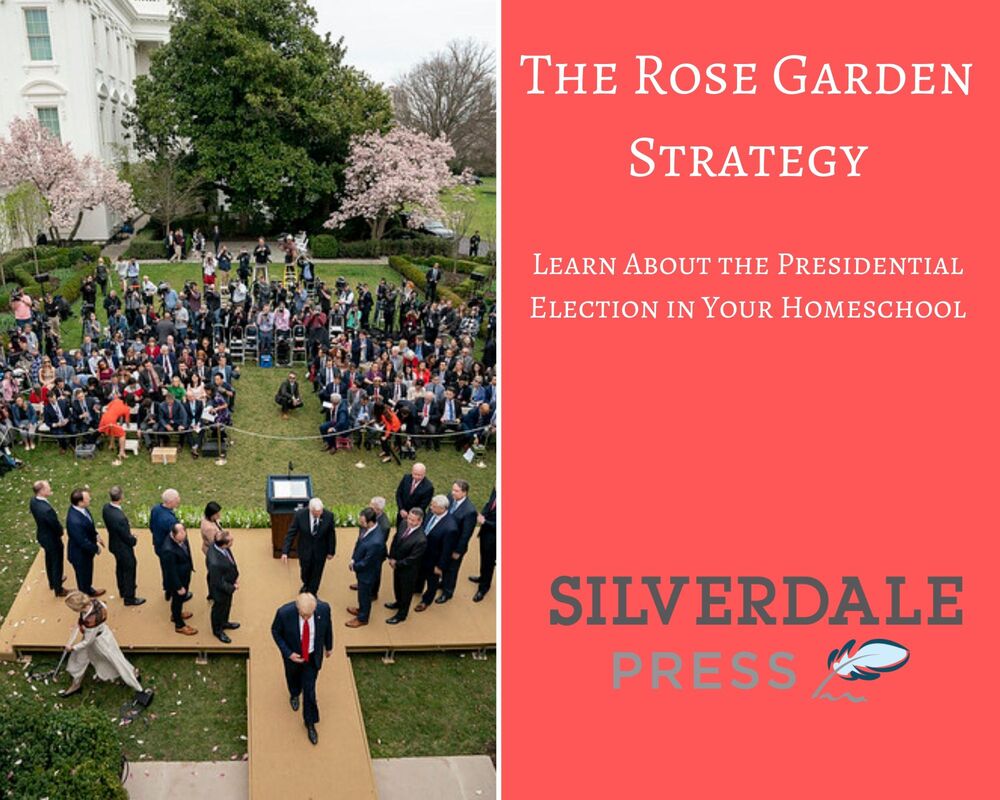|
We hope and pray that your homeschool is safe and even thriving during this time of crisis and uncertainty. In this newsletter, we provide you with some resources for studying the presidential election in this extraordinary time. This week, we’ll be looking at the Rose Garden strategy, happening now. The Rose Garden strategy is especially important in times of crisis.
If you haven’t already, check out our new Presidential Election Unit Study 2020. It’s perfect for your homeschool or co-op. Download our free lesson on the presidential primaries. We are in the middle of the presidential primary season right now, so this is a great opportunity to make learning come alive. Though the campaign season has been disrupted—events canceled, elections pushed back, and conventions postponed—the season is still filled with learning opportunities. 1. What is the White House Rose Garden? Before we learn about the Rose Garden campaign strategy, you need to know about the White House Rose Garden. The White House Rose Garden is a garden, of course. More important is its location. It borders the Oval Office, where the president works, and the West Wing, where the Oval Office is located and the president’s staff work. It is about 125 feet long and 60 feet wide. Ever since John F. Kennedy was president, roses have been the featured flowering plant in the garden, though many other flowers bloom throughout the seasons. The Rose Garden is used for ceremonies and events. Presidents hold news conferences in the Rose Garden. They make important announcements about laws and policies from the Rose Garden. In short, the Rose Garden is a beautiful, historic, weighty backdrop for governing—and campaigning. 2. What is the Rose Garden strategy? The Rose Garden strategy is a re-election strategy that only incumbent presidents can use, when they are running for re-election. An incumbent is the person who has held the office before. So, the Rose Garden strategy is an important strategy in 2020, when an incumbent president is running for re-election. But it was not an important strategy in 2016, because an incumbent was not running. The Rose Garden strategy refers to staying inside the grounds of the White House, taking care of the business of governing, instead of traveling around the country on the campaign trail—meeting and greeting citizens, speaking at rallies. Of course, the Rose Garden is not the only place from within the White House that a president wages a campaign. The president also speaks from a podium in the James S. Brady Press Briefing Room, a workspace for the media in the first floor West Wing corridor. On really important occasions, the president also sometimes speaks to the nation from behind the desk in the Oval Office. Though presidential speeches may be given in different locations, they all count as the Rose Garden strategy. By focusing on events in the White House, presidents can capture the grandeur and prestige of their office. They can look presidential. They can use the White House as a dramatic backdrop. They can capture a large audience because the media will cover events and even air them live. 3. Rose Garden Strategy in History and Crisis The Rose Garden strategy has been important in the history of presidential elections. But it has been especially important in times of crisis. In times of crisis, it is important for presidents to be in the White House, responding to the crisis by exercising presidential powers. As a campaign strategy, this can pay dividends. Presidents can stay in front of voters. And voters will listen because they are anxious. Presidents can be the star of the show, the nerve center of leadership for the nation. In 1976, candidate Jimmy Carter accused President Gerald Ford of using the Rose Garden strategy to get himself free press coverage. For example, in October of 1976, President Ford invited Queen Elizabeth II to a White House celebration to mark America’s bicentennial. The Queen’s visit got loads of positive attention, though Ford ended up losing to Carter in the end. But in 1980, President Jimmy Carter used the Rose Garden strategy when he was running for re-election. America was in the middle of the Iran hostage crisis. This was a standoff between the U.S. and Iran, after a group of Iranian students stormed the U.S. Embassy in Tehran and held 52 Americans hostage for 444 days. In April of 1980, Carter ordered the military to attempt a rescue mission, which failed. The constant media coverage of the hostage crisis was not a positive backdrop for Carter’s reelection. He couldn’t resolve the crisis, he didn’t much go out on campaign trail, and his Rose Garden strategy backfired. The hostages were released as soon as Ronald Reagan took the oath of office on January 21, 1981. We encourage your homeschool family to use this extraordinary time to study the presidential election. We hope this lesson on the Rose Garden strategy has helped you to understand the political background of this extraordinary moment in political history. Don’t forget to download our free lesson on the presidential primaries, and get your copy of the Presidential Election Unit Study 2020 for homeschools and co-ops! Here are some key terms and activities on the Rose Garden strategy for your homeschool as you study the presidential election: Key Terms Incumbent James S. Brady Press Briefing Room Oval Office Rose Garden strategy White House Rose Garden Activities
Question for Debate and Discussion
0 Comments
Leave a Reply. |
Silverdale PressCheck out our About Page to learn more about us! Categories |


 RSS Feed
RSS Feed